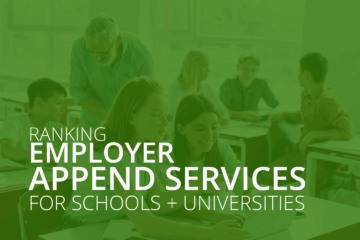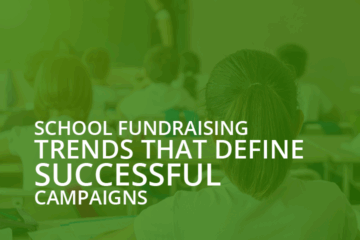5 Questions About CRMs No One Asks (But Everyone Should!)
Fundraising trends come and go. Today’s artificial intelligence (AI) and digital wallets overshadowed yesterday’s social media challenges and virtual events. But some tools prove themselves indispensable, no matter how the landscape shifts. Your constituent relationship management (CRM) system falls into that category.
CharityEngine’s roundup of top CRMs explains the platform’s importance like this: A CRM centralizes donor data and automates tasks, providing all the features an organization needs to reach donors in the ways that engage them most. In other words, it’s the engine that fuels donor engagement, retention, and long-term growth.
In this guide, we’ll cover the lesser-known CRM questions every school fundraiser should ask before selecting a solution. By looking past the obvious and asking smarter questions, your school can invest in a platform that saves time, supports your goals, and makes fundraising easier.
Is the CRM flexible enough to support your fundraising model?
Schools often juggle a wide range of fundraising initiatives, each with its own audience and goals. From a booster club’s community fun run supporting the school’s sports program to the PTA’s auction raising money for the arts department, schools need technology flexible enough to manage their unique mix of campaigns.
Before selecting a CRM, it’s worth asking whether the technology can effectively align with your fundraising reality.
Here are some key questions to consider:
- Can the CRM accommodate your most common fundraising formats? Consider the source of your school’s fundraising dollars. Is it peer-to-peer student campaigns, parent-led events, or year-end appeals? Your CRM should offer the tools you need to host the type of campaign that will garner the most support.
- Does it support multiple programs or campaigns running concurrently? Schools rarely run one initiative at a time. A strong CRM can facilitate all of your initiatives at once. For example, it should allow the drama club to sell tickets, the PTA to organize a fun run, and the alumni association to reach out for a capital campaign.
- Can you tailor donor-facing forms and workflows to different audiences (parents, alumni, businesses)? Whether you’re interacting with students, alumni, their families, or one of your school’s corporate partners, your CRM should make it easy to reach them. Look for a solution that enables customized donation forms and automates communications, ensuring each audience feels recognized and appreciated.
By prioritizing CRMs with the tools your school needs, you can feel confident your technology is working with your fundraising landscape, not against it.
What does onboarding and training really look like?
Most fundraising teams have several areas of focus, such as prospect research, event planning, marketing, and donor outreach. Depending on your school’s resources, these roles likely necessitate volunteer recruitment, which 360MatchPro’s statistics note is the top challenge for volunteer managers year after year.
For your school, this means switching to a new CRM isn’t just about migrating data—it’s about ensuring users can get up and running confidently. Even the most powerful CRM will fall short if fundraising teams and volunteers feel overwhelmed or underprepared.
When evaluating CRMs, ask vendors how they approach onboarding. Ask whether their training programs will match your needs. Here are some ways you can get this conversation started:
- Is training included, and is it tailored to schools? Training should certainly cover how to use the software, but it should also reflect the fundraising realities a school might face. For example, do they explain the basics of payroll giving or how to set up a booster club campaign? Tailored training means your staff can immediately apply what they learn.
- Are onboarding resources (like checklists or video tutorials) available? It’s hard to retain every word spoken during a live call. Look for vendors that supply supporting materials, such as step-by-step checklists, how-to videos, and written guides that your staff can refer to later. Sometimes, even recording training calls will help, and all of these will be invaluable when adding PTA members or new staff to the software.
- What kind of support is available during the first 90 days? The first three months are critical for long-term adoption. Ask whether you’ll have access to dedicated support, such as an implementation specialist. This level of attention can make all the difference between frustration and smooth sailing.
Ultimately, the success of your technology investment depends on how quickly and effectively your team embraces it. A thoughtful onboarding plan backed by relevant training and support will lay the groundwork for long-term fundraising success.
How will the CRM grow with your fundraising program?
A successful fundraising program shouldn’t stay the same year after year. What may begin as a simple campaign, like a bingo night or a fun run, can quickly expand in scope and impact. Those can also branch into more complex campaigns, such as alumni giving, recurring donor programs, and major gift cultivation.
The last thing you want is to outgrow your CRM and be forced to switch systems again. When shopping for a CRM, think beyond what you need today and consider whether your platform can support your growth. Here are some questions to consider:
- Does the platform have features for scalable campaigns? As your fundraising expands, you may need more advanced tools. They might include peer-to-peer fundraising, recurring gift management, or event management. A scalable CRM should be able to handle a capital campaign or an alumni giving campaign (tracking pledges, managing major gifts, and creating personalized communications) even if those plans aren’t on your radar yet.
- Are integrations with other platforms available if you need to scale operations? Schools often rely on multiple tools, like learning management systems, accounting software, and more. A CRM that integrates seamlessly with these platforms will reduce manual work and keep your data connected. Even if you don’t need the integrations today, it’s worth knowing whether the option will be available when you grow.
- What does pricing look like if your donor base or outreach expands? Be wary of CRMs that seem very affordable yet limit your number of contacts or campaigns. Always ask about pricing models: will costs increase as you add donors, users, or initiatives?
Choosing a CRM that will grow with you means your technology won’t hold you back from building upon your fundraising success. By investing in technology that will meet you tomorrow, you’re making it easier to raise money today, too.
Can you pull useful reports without being a tech expert?
Are you a little intimidated by the feature CRMs call “robust reporting?” All too often, it means you need a degree and advanced query skills to get the information you want.
Most schools don’t have data analysts on staff. You want a CRM that offers intuitive, user-friendly dashboards and reporting tools tailored to the fundraising metrics you care about. Whether it’s the principal, PTA president, or coach, everyone on your team should be able to log in and quickly understand how a campaign is doing—without an IT background.
Here are some questions you can ask to gauge reporting usability:
- Can you easily generate key reports? Look for systems that make it easy to pull the reports you’ll need most often, such as donor retention, marketing effectiveness, campaign ROI, or volunteer hours logged.
- Are dashboards customizable or templated for fundraising metrics? A good CRM offers both off-the-shelf dashboards and the ability to customize them to see the data you want.
- How quickly can you export and share data with stakeholders? Schools often need to share data with multiple stakeholders, such as administrators, the PTA, or community partners. Make sure your CRM allows you to export reports into shareable formats like PDFs.
Accessible, actionable reporting empowers school teams to make informed decisions in real-time, whether that means tweaking a campaign or celebrating success as it unfolds.
How does the CRM support donor relationships beyond transactions?
A CRM should be more than a digital filing cabinet for donations. After all, fundraising isn’t only about dollars.
Ideally, a CRM should be relationship-focused, helping schools strengthen their donor cultivation strategies. As you evaluate potential solutions, look for features that go beyond recording donations and support relationship-building:
- Communication tools, like email templates or texting features
- Donor engagement history tracking
- Audience segmentation and message personalization tools
- Automation for donor thank-yous or recurring gift reminders
When your CRM makes it easy to personalize outreach and recognize supporters in ways that matter, you increase donor loyalty and lifetime value.
Choosing the right CRM is about more than ticking off a list of features. It’s about finding an all-in-one solution that simplifies fundraising, reporting, and donor engagement so your school has every fundraising tool it needs in one place.
Technology can make or break your school’s fundraiser. The right technology allows you to raise more money and build lasting relationships that strengthen your school community.



